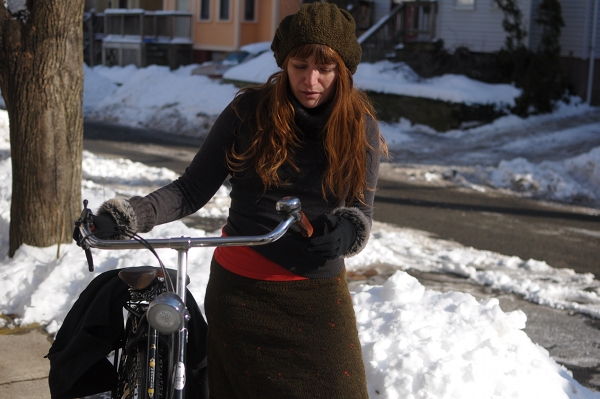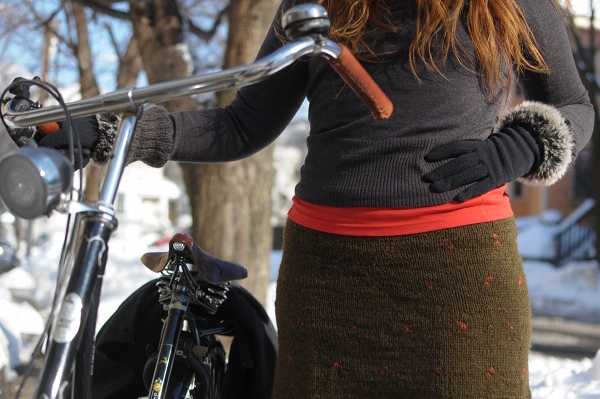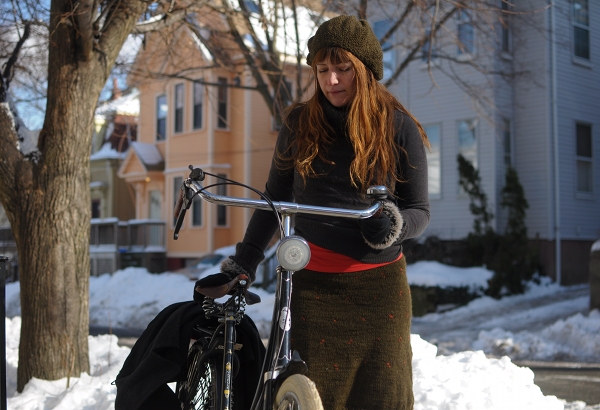Despite this winter being colder than last, I am finding cycling in freezing temperatures easier this time around. The reason, is that I have finally surrendered to wool. Clad in head to toe wool, I no longer complain about the cold and life has gotten easier. Pictured here: a long sleeve wool t-shirt from Icebreaker (the red bit sticking out), wool sweater and gloves from Jigsaw, wool skirt and hat that I knitted myself, and wool coat (folded over the back of the bike) from Benetton. Not visible here are Icebreaker leggings, Smartwool socks, and I/O Bio underwear and bra - also all wool.
I've certainly worn wool in the past, and - like Dottie from Let's Go Ride a Bike - I have always loved sweaters with enormous turtle/cowl necks that can be unfolded over my face to protect against the frost. But before this year, I have limited wool clothing to outer layers, and did not think I was tolerant of wool right next to my skin. That was why I repeatedly ignored advice that was given me last year to buy lightweight "technical" wool. I remember trying to wear wool shirts and tights next to my skin before, and finding them irritatingly itchy. Today's manufacturers of technical wool - the most popular being Smartwool, Ibex and Icebreaker - promise featherweight, itch-free garments. But they are also super expensive. It took me a long time to suspend my disbelief and commit to giving these things a try, and it also took me a long time to find everything I wanted on sale. But now that I have, I can never go back. The stuff works, and it really is non-itchy - even for someone whose skin is normally sensitive to wool.
I am not sure how exactly "technical wool" is made, and most likely every manufacturer's version is different. But the idea is, that the merino fibers are kept super fine, but made to interlock in a way that results in efficient temperature regulation. In comparison, if you examine a "regular wool" garment - like the sweater I am wearing here - you will find that it is more porous, not quite as smoothly textured, and thicker. Even the finest merino and cashmere sweaters do not have the same tissue-weight quality and smooth, dense texture as the technical wool garments.
All this makes it possible to wear "technical wool" next to one's skin, and for those struggling with the cold, I would highly recommend it. Wearing a wool sweater and overcoat did nothing for me last year, when the stuff I'd wear underneath was made of cotton or some other fabric. My underlayers would get soaked with sweat, and then the wind would chill me to the bone when I would stop at intersections. The feeling of my skin being covered with frozen sweat underneath three layers of clothing was just awful. But wearing wool underwear, bra, tights, and long-sleeve tee, has solved this problem for me completely. As far as the difference between the popular brands, I think they are all pretty good and I just get whatever is on sale. For ultra-thin layers, I prefer Icebreaker. And I also love Icebreaker leggings - they are gusseted, whereas Smartwool leggings are not.
For layers that are not directly next to the skin, I find "regular" wool sufficient - either store bought wool clothing, or things I knit myself. While Smartwool, Ibex, Icebreaker and others do offer technical outer layers, I think it is just too expensive for most people to amass an entire wardrobe out of that stuff. And, of course, it is also stylistically limiting. For me, as long as the layers next to my skin are the technical garments, I can wear pretty much anything over them and it will feel fine. I like to knit my own hats and skirts, because making them is fairly easy and I can invent my own styles. But sweaters are complicated, so mine are all store-bought.
One thing to keep in mind, is that thin merino sweaters are usually warmer than chunky sweaters, because the tightly-knit merino is less porous. Unfortunately, I have noticed lately that even stores that used to sell simple wool sweaters no longer do: I could not find a single sweater at our local Gap, Old Navy, or Banana Republic stores that was 100% wool over the past couple of seasons - and I checked at various points in time out of curiosity. Several years ago, you could walk in and buy a wool sweater without a problem, so I wonder what accounts for this change. Has the price of wool risen? J. Crew still offers a good variety of merino sweaters, as well as cashmere, but I wonder whether that is on its way out as well. It would be a shame, since it seems that an increasing number of people are re-discovering the benefits of natural fibers over synthetics - particularly in the winter. What are your experiences with "regular" wool, "technical" wool, and other fibers?










0 comments:
Post a Comment